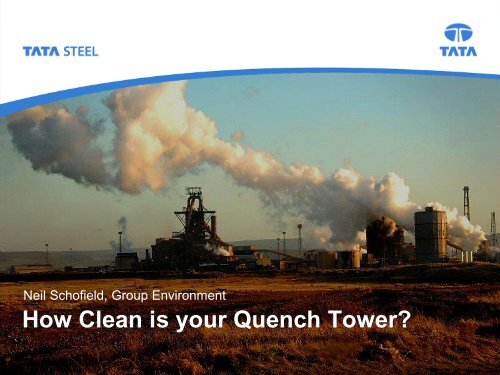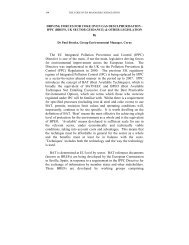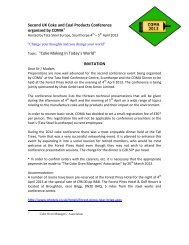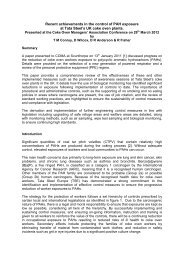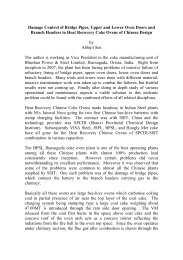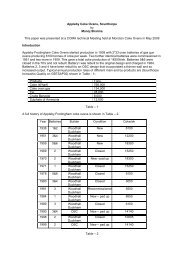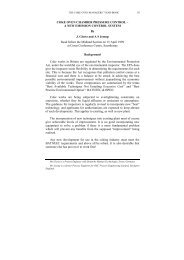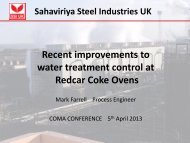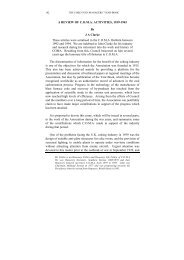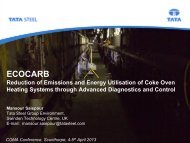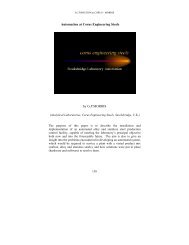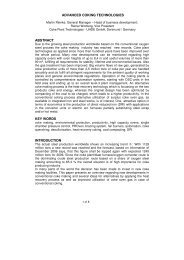How Clean is your Quench Tower? - Coke Oven Managers ...
How Clean is your Quench Tower? - Coke Oven Managers ...
How Clean is your Quench Tower? - Coke Oven Managers ...
Create successful ePaper yourself
Turn your PDF publications into a flip-book with our unique Google optimized e-Paper software.
Neil Schofield, Group Environment<br />
<strong>How</strong> <strong>Clean</strong> <strong>is</strong> <strong>your</strong> <strong>Quench</strong> <strong>Tower</strong>?
<strong>Coke</strong>making in Today’s World<br />
HMIP or Alkali Inspectorate<br />
regulated, limits for stack<br />
em<strong>is</strong>sions based on the<br />
Alkali Act 1906<br />
Integrated Pollution Prevention and<br />
Control (IPPC). Introduces BAT and the<br />
BAT reference documents (first time<br />
quench em<strong>is</strong>sion range <strong>is</strong> documented in<br />
UK)<br />
Environmental Protection Act<br />
(EPA) aims to control and<br />
reduce pollution through<br />
author<strong>is</strong>ation of processes and<br />
tighter limits for stack em<strong>is</strong>sions.<br />
Introduces BATNEEC<br />
Industrial Em<strong>is</strong>sions Directive<br />
(IED). Rev<strong>is</strong>ion of BAT<br />
documents and introduction of<br />
BAT-AELs (associated em<strong>is</strong>sion<br />
levels)<br />
1980s 1990s 2000s 2010s<br />
2
BAT for coke quenching<br />
• Reduce dust em<strong>is</strong>sions by using one of the<br />
following techniques:<br />
• using coke dry quenching (CDQ) with the recovery<br />
of sensible heat and the removal of dust from<br />
charging, handling and screening operations by<br />
means of a bag filter<br />
• using em<strong>is</strong>sion-minim<strong>is</strong>ed conventional wet<br />
quenching<br />
• using coke stabil<strong>is</strong>ation quenching (CSQ)<br />
• BAT-AELs for dust are:<br />
< 20 mg/Nm³ (in case of CDQ)<br />
< 25 g/t coke (in case of wet quenching)<br />
• th<strong>is</strong> level <strong>is</strong> based on the use of the non-<strong>is</strong>okinetic<br />
Mohrhauer method (former VDI 2303)<br />
< 10 g/t coke (in case of CSQ)<br />
3
Mohrhauer method (former VDI 2303)<br />
4
Application of the Mohrhauer Method<br />
5
Some UK <strong>Quench</strong> <strong>Tower</strong> Em<strong>is</strong>sions<br />
Plant<br />
Coarse<br />
Particulate<br />
Em<strong>is</strong>sion<br />
(g/t coke)<br />
BREF Range
Loss of Stat<strong>is</strong>tical Life Expectancy (months)<br />
through exposure to fine particulate<br />
7
Measuring Total Particulate Matter (TPM)<br />
8
Application of TPM with Mohrhauer<br />
9
Total Particulate Results (Plants A and F)<br />
Plant<br />
Total<br />
Particulate<br />
Coarse<br />
Particulate<br />
(g/t coke)<br />
Fine<br />
Particulate<br />
Factor<br />
(Total : Coarse)<br />
A 56 12 (44) 5.3<br />
F 684 622 (62) 1.1<br />
Particle Size<br />
D<strong>is</strong>tribution of<br />
Total Particulate<br />
Size Cumulative %<br />
>PM10 100<br />
PM10 5.3<br />
PM2.5 5.0<br />
PM1 3.5<br />
10
Compar<strong>is</strong>on of Em<strong>is</strong>sions (Plants A and F)<br />
Plant A Plant F Plant A Plant F<br />
• Coarse • Fine • PM 10<br />
11
Total Particulate Results<br />
Plant<br />
Total<br />
Particulate<br />
Coarse<br />
Particulate<br />
(g/t coke)<br />
Fine<br />
Particulate<br />
Factor<br />
(Total : Coarse)<br />
A 56 12 (44) 5.3<br />
F 684 622 (62) 1.1<br />
D1 18 14 (4) 1.3<br />
D2 12 4 (8) 3.5<br />
• Factors affecting the em<strong>is</strong>sion of fine particulate<br />
• <strong>Quench</strong> tower height and design?<br />
• <strong>Coke</strong> and/or quench quality?<br />
• <strong>Quench</strong> water quality?<br />
12
Actions to comply with BAT-AEL<br />
• Investment in state of the art quench tower<br />
• Tall tower, multiple baffles, baffle spray cleaning<br />
• Reduction of suspended solids and soluble salts in quench water<br />
• Investment in alternative quenching technologies<br />
• No quench plume with CDQ, only abated stack release<br />
• Understand that level <strong>is</strong> applicable to coarse dust only<br />
• PM 10 <strong>is</strong> a minor component of the quench tower em<strong>is</strong>sion<br />
• Research into the range of fine particulate em<strong>is</strong>sions from quench towers in<br />
order to set an achievable level<br />
13
Summary<br />
• <strong>Coke</strong>making in today’s world <strong>is</strong> subject to ever stringent environmental<br />
regulation<br />
• <strong>Quench</strong> tower em<strong>is</strong>sions have recently become the focus of regulators<br />
and em<strong>is</strong>sion limit values are expected in the future<br />
• <strong>Quench</strong> tower em<strong>is</strong>sions are difficult and costly to achieve, and<br />
standard measurement techniques do not provide the full story<br />
• <strong>Quench</strong> tower em<strong>is</strong>sions have been undertaken in the UK to allow<br />
cost-effective investment dec<strong>is</strong>ions to be made<br />
14
Thank you<br />
Neil Schofield<br />
Knowledge Group Leader<br />
Environmental Engineering and Monitoring<br />
T +44 (0) 1709 825569 (direct)<br />
F +44 (0) 1709 825400<br />
M +44 (0) 7825 522343<br />
neil.schofield@tatasteel.com<br />
Tata Steel Group Environment<br />
Swinden Technology Centre<br />
Moorgate, Rotherham,<br />
South Yorkshire S60 3AR,<br />
United Kingdom<br />
15


